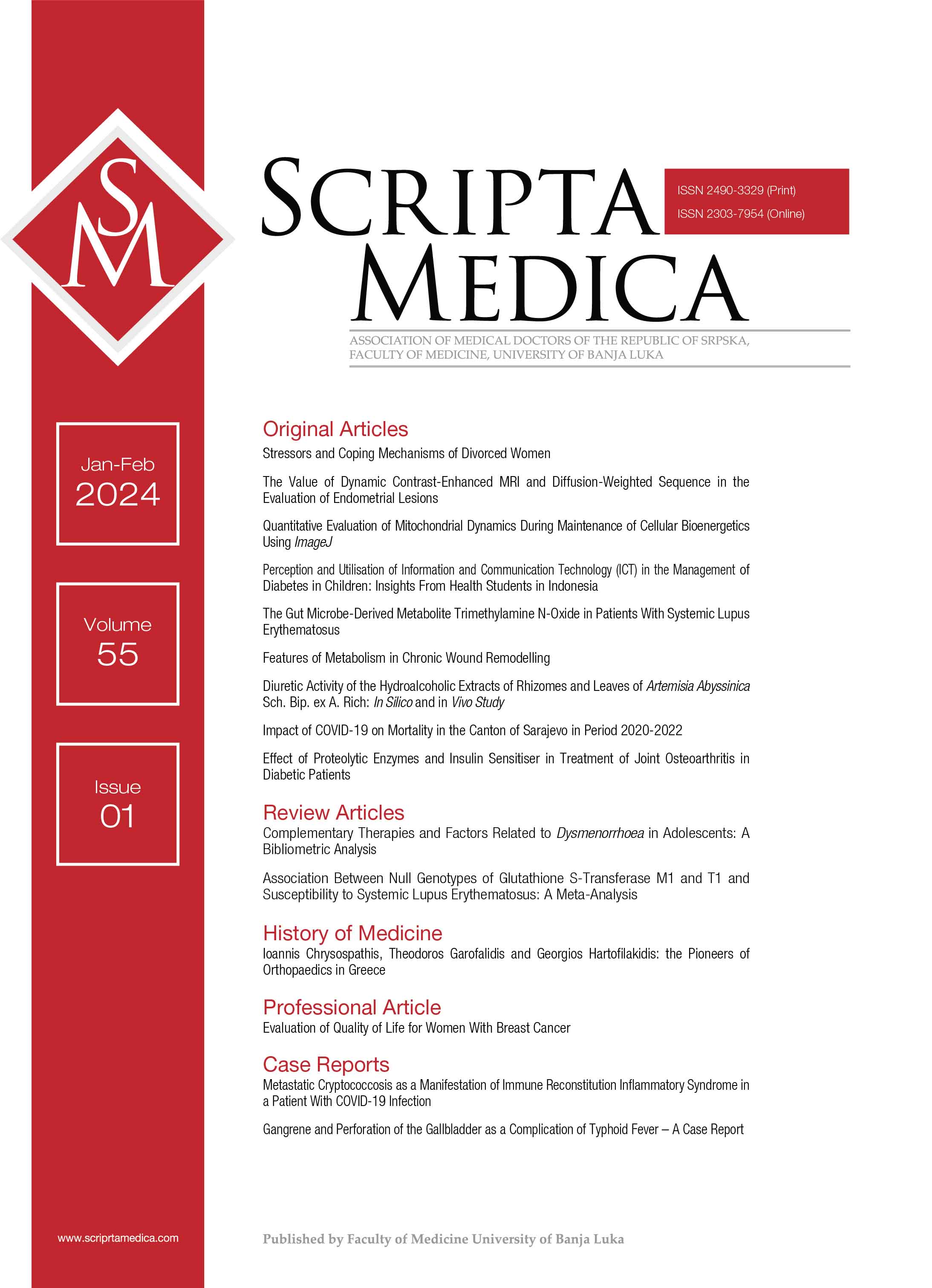Impact of COVID-19 on Mortality in the Canton of Sarajevo in Period 2020-2022
Abstract
Background/Aim: Until March 2023, it has been reported over 676 million cases of COVID-19 globally with almost 7 million deaths caused by this disease. Aim of this study was to determine COVID-19-related deaths and to study how COVID-19 pandemic impacted mortality of residents in the Canton of Sarajevo in 2020-2022 time period. Also, aim was to analyse to what extent the number of registered non-COVID-19-related deaths have changed in the Canton of Sarajevo compared to what would have been expected in the absence of the virus to better measure the impact of COVID-19.
Methods: This study used mortality data obtained from Federal Institute for Statistics for period 2017-2022. Data was analysed and presented as raw numbers, age-, sex-, cause of death - crude death rates (CDR), excess mortality and P-score.
Results: CDR in the Canton of Sarajevo in 2020 was 1246.3 per 100.000 persons, 1488.6 in 2021 and 1153.4 in 2022, while in period from 2017-2019 CDR ranged from 1051.3 to 1057.9. Total CDR in 2020 increased by 18.3 % compared to 2017-2019 average CDR, this relative difference being even greater in 2021 (41.3 %) and lower in 2022 (9.5 %). In 2020-2022 time period, 9 of the 10 leading causes of death remained the same as in 2019. COVID-19 was the 3rd leading cause of death in 2020 and 2022, while in 2021 spiked as the leading cause of death. In 2020 there was increase of 7 % in deaths from non-COVID-19 related deaths compared to mean number of deaths for period 2017-2019. As for 2021, this number goes higher (9.5 %) and in 2022 was much lower (1.0 %).
Conclusion: In the Canton of Sarajevo, COVID-19 pandemic made a big impact on mortality in 2020-2022 years period. Data have changed in total mortality, leading causes of death and excess mortality. Deep-rooted organisational weaknesses that were exposed during pandemic that can bring harm to population from preventable chronic diseases needs to be addressed which have impact on morbidity and at the end, on mortality.
References
Johns Hopkins University. Covid-19 Dashboard by the Center for Systems Science and Engineering. 2021 [Internet]. [Cited: 14-Jul-2023]. Available from: https://coronavirus.jhu.edu/map.html.
Tafti AD, Fatehpanah A, Salmani I, Bahrami MA, Tavangar H, Fallahzadeh H, et al. COVID-19 pandemic has disrupted the continuity of care for chronic patients: evidence from a cross-sectional retrospective study in a developing country. BMC Prim Care 2023 Jul 1;24(1):137. doi: 10.1186/s12875-023-02086-6.
Our World in Data. A pandemic primer on excess mortality statistics and their comparability across countries. [Internet]. [Cited: 15-Jul-2023]. Available from: https://ourworldindata.org/covid-excess-mortality.
Murphy SL, Kochanek KD, Xu JQ, Arias E. Mortality in the United States, 2020. NCHS Data Brief 2021;427:1-8.
Rivera R, Rosenbaum JE, Quispe W. Excess mortality in the United States during the first three months of the COVID-19 pandemic. Epidemiol Infect 2020 Oct 29;148:e264. doi: 10.1017/S0950268820002617.
World Health Organization. International guidelines for certification and classification (coding) of COVID-19 as cause of death. [Internet]. [Cited: 15-Jul-2023]. Available from: https://www.who.int/classifications/icd/Guidelines_Cause_of_Death_COVID-19.pdf?ua=1.
Karin Modig K, Ahlbom A, Ebeling M. Excess mortality from COVID-19: weekly excess death rates by age and sex for Sweden and its most affected region. Eur J Public Health 2021;31(1):17–22.
Zur Nieden F, Sommer B, Luken S. Sonderauswertung der Sterbefallzahlen. Wirtsch Stat 2020;72:38–50. [Internet]. [Cited: 15-Jul-2023]. Available from: https://www.efgs2021.de/DE/Methoden/WISTA-Wirtschaft-und-Statistik/2020/04/sonderauswertung-sterbefallzahlen-042020.pdf;jsessionid=F12B5D6AF2CBF7FC68C5EA134FDEB698.live731?__blob=publicationFile. German.
Ritchie H, Mathieu E, Rodés-Guirao L, Appel C, Giattino C, Ortiz-Ospina E, Hasell J, Macdonald B, Beltekian D, Roser M. Coronavirus Pandemic (COVID-19). [Internet]. [Cited: 21-Jul-2023]. Available from: https://ourworldindata.org/coronavirus.
Locatelli I, Rousson V. A first analysis of excess mortality in Switzerland in 2020. PLoS One 2021 Jun 17;16(6):e0253505. doi: 10.1371/journal.pone.0253505.
Cheng S, Zhao Y, Wang F, Chen Y, Kaminga AC, Xu H. Comorbidities’ potential impacts on severe and non-severe patients with COVID-19: A systematic review and meta-analysis. Medicine (Baltimore) 2021 Mar 26;100(12):e24971. doi: 10.1097/MD.0000000000024971.
Mitrani RD, Dabas N, Goldberger JJ. COVID-19 cardiac injury: Implications for long-term surveillance and outcomes in survivors. Heart Rhythm 2020;17:1984-90.
Karlinsky A, Kobak D. Tracking excess mortality across countries during the COVID-19 pandemic with the World Mortality Dataset. eLife 2021;10:1-21.
Erdal GS, Polat O, Erdem GU, Korkusuz R, Hindilerden F, Yilmaz M et al. The mortality rate of COVID-19 was high in cancer patients: a retrospective single-center study. Int J Clin Oncol 2021;26:826-34.
Gupta K, Gandhi S, Mebane A, Singh A, Vishnuvardhan N, Patel E. Cancer patients and COVID-19: Mortality, serious complications, biomarkers, and ways forward. Cancer Treat Res Commun 2021;26:1-5.
- Authors retain copyright and grant the journal right of first publication with the work simultaneously licensed under a Creative Commons Attribution License that allows others to share the work with an acknowledgement of the work's authorship and initial publication in this journal.
- Authors are able to enter into separate, additional contractual arrangements for the non-exclusive distribution of the journal's published version of the work (e.g., post it to an institutional repository or publish it in a book), with an acknowledgement of its initial publication in this journal.
- Authors are permitted and encouraged to post their work online (e.g., in institutional repositories or on their website) prior to and during the submission process, as it can lead to productive exchanges, as well as earlier and greater citation of published work (See The Effect of Open Access).

